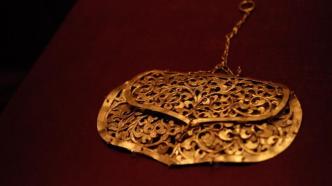
The biography of Zhang Kan’s "Hunting Horses" in the Freer Gallery of Art in the United States is rarely mentioned in the academic circles. According to the research of this paper, "Hunting Horses" and six paintings by Southern Song Dynasty court painter Chen Juzhong are in the They are very similar in style; judging from the hair style, robes, boots and hats, barrier mud decorations and horse guard rings in the painting, it can be judged that the object depicted in the painting is the Jurchen tribe.
From the 10th to the 13th centuries, the Khitan and Jurchen nomadic peoples originated in Muye Mountain and Baishan Heishui respectively, and successively established the Liao (916-1125) and Jin (1115-1234) dynasties. The Jin ruled the Liao Dynasty, and Jurchen was a vassal of the Liao Dynasty before the founding of the country in 1115. The two tribes also had the customs of shooting and hunting in the spring and autumn, and wearing hair and narrow sleeves. Haidongqing hit it, or shot it himself." Since the Khitan and Jurchen tribes have considerable similarities in clothing, four-season bowls, and national characters, if the Fanma paintings of this period lack the artist's seal and postscript, and there is no exact date and no historical records of the paintings, how can they be determined? The ethnic affiliation of the subjects depicted has thus become a thorny art-historical issue. Furthermore, from the 10th to the 13th centuries, apart from the Khitan and Jurchen painters, the court painters of the Northern Song Dynasty (960-1127) and the Southern Song Dynasty (1127-1279) who served as envoys to the North were all able to paint and describe the Fanma they saw. Therefore, it is another difficult question whether the painters were the painters of the Song, Liao, and Jin Dynasties.
Aware of this, Yuhui in the 1990s and Peng Huiping in the 2000s devoted herself to distinguishing the differences between the Liao and Jin ethnic groups and analyzing the uniqueness of the Jurchen ethnic group in the study of ancient calligraphy and painting. Yu Hui combined ethnology and archaeology, and used archaeological materials such as tomb murals to clarify the hairstyles and types of utensils of Liao, Jin, and Xixia. "Zhuo Xie Tu" volume, "Liu Pond Herding Horses Tuan Tuan Fan" depicting object changed to Jurchen.
The author's series of studies on "Horse Butt Stamping and Fanma Painting Identification" (2002-2004) started from the perspectives of Liao and Jin characters and Southern Song court painters envoys envoys into gold. Large and small characters, Jurchen characters and other fire-printed characters. The author points out that the Jurchen characters were first created by Jin Taizu in 1119, which has a clear age limit. Therefore, if the Jurchen characters appear in the paintings, the upper limit of the painting is 1119, and the objects depicted must be Jurchens. The painters of the Song and Song Dynasties who set foot in the Jin Dynasty between 1119 and 1210, such as Chen Juzhong (active after 1160-1232), the court painter of the Southern Song Dynasty envoy to the Jin Dynasty, had the opportunity to see the Khitan and Jurchen clans that coexisted in the society of the Jin Dynasty Word.
Comprehensively considering the brush-and-ink composition and motif style in the painting, the author verified that the collections of Hu Yu's "Hunting Picture" and "Hunting Picture" in the National Palace Museum in Taipei were written by Fanma painters in the Xuanhe Dynasty (1119-1125) of the Northern Song Dynasty, Taipei National Palace Museum The Museum's "Eighteen Pads of Hu Jia" was written by a painter at the end of Shaoxing in the Southern Song Dynasty (1160s). The Boston Museum of Fine Arts' "Eighteen Pads of Hu Jia" is a work in the mid-Southern Song Dynasty, which influenced the later Southern Song Ning and Li Zong Chao Chen is in the middle. On this basis, this article focuses on Zhang Kan's "Hunters on Horseback" (F1909.160) collected by the Freer Museum of Art in the United States. Guo Ruoxu's "Pictures and Experiences" written in 1075 only briefly mentioned Zhang Kan as "Waqiao man. He painted horses and lived near Yanshan Mountain. He got the wonderful shape and bones of Hu people and the essence of military clothes and saddles. However, people call him Having a high reputation, the horse has lost its predecessors, and now it is unique." Zhang Kan, a Waqiao painter who lived near Yanshan in the middle of the 10th century, lacks reliable surviving authentic works, and his descriptions in "Pictures and Experiences" and "Xuanhe Painting Book" are seldom written.
However, this unpopular painter who has been studied by no one and depicts the life of Khitan is not lacking in the Freer Museum of Art. There are two Zhang Kan silk paintings in Freer's warehouse. The first is the scroll of "Removing the Saddle and Inspecting the Arrows" (Removing the Saddle and Inspecting the Arrows, F1916.526), which was studied by the author; "Hunting and Riding Picture". Both paintings belong to the former collection of Liang Qingbiao (1620-1691), but they are actually not from the Zhang Kan painting series. When the author was doing postdoctoral research at the Freer Art Museum at the Smithsonian Institution in 2007-2008, he observed two paintings carefully in the warehouse and wrote this article.
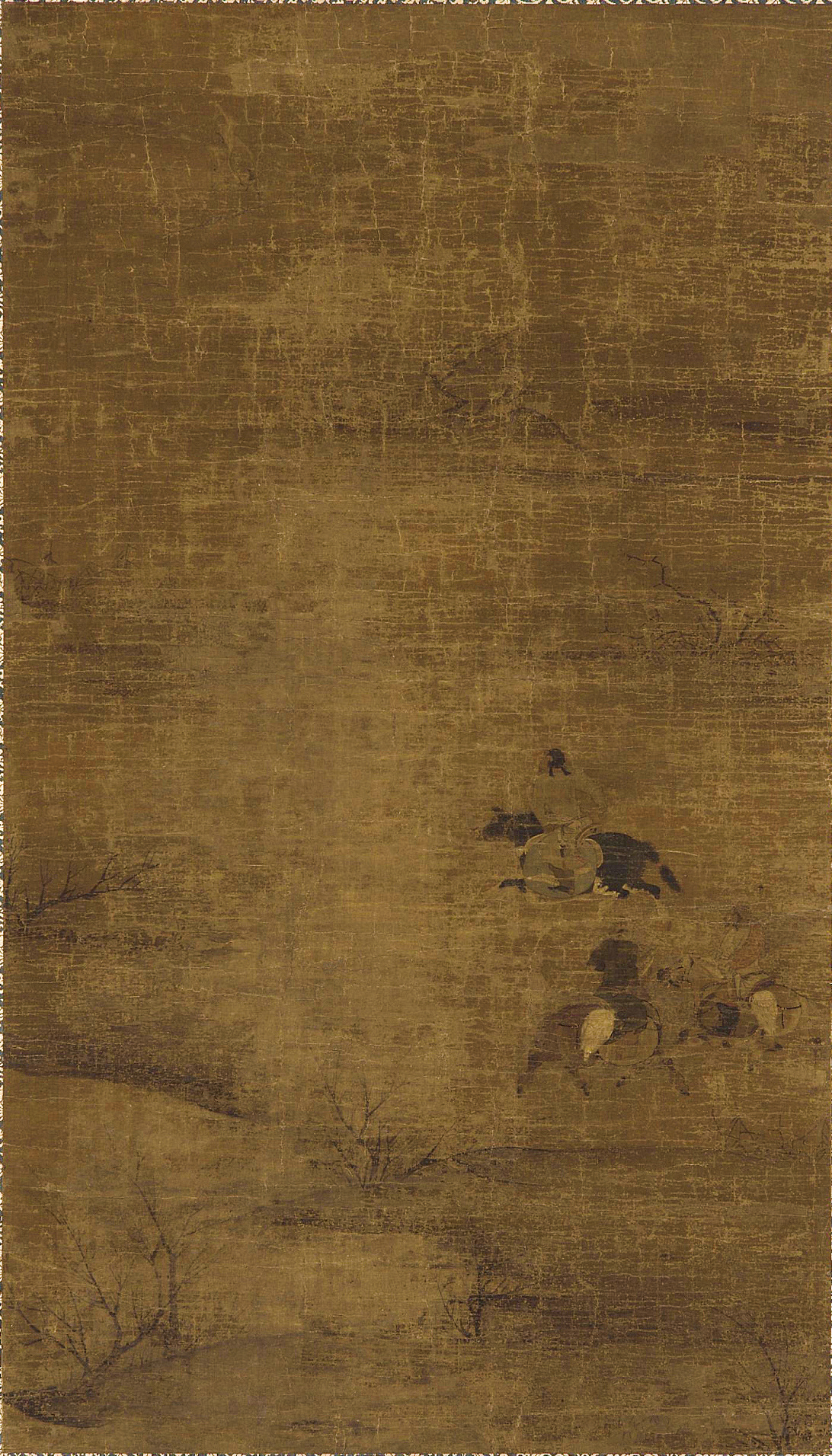
〔Picture 1〕 Chuan Zhang Kan's "Hunting Horse", axis, collection of Freer Museum of Art, plate authorized by Freer Museum of Art
It is said that Zhang Kan's "Hunting and Riding Picture" (Fig. 1) is ink and color on silk, with a length of 91.3 cm and a width of 52.3 cm. It has no author's seal, description, and early Tibetan seals. It lacks collection records before the Qing Dynasty. In 1909, Charles L. Freer (1854-1919) bought the axis of "Hunting Horses" from Loon Gu Sai, an antique shop in Beijing, and brought it to Washington. In 1920, Charles L. Freer donated the collection of paintings to the Freer Museum of Art ‹9›. In 1948, Freer's framer Kinoshita Yokichi re-mounted the painting on a wood block, and re-mounted the three titles of the original scroll, including Liang Qingbiao, Yi Nianzeng (1790-1861), and Kara Tsubaki, on the back of the block :
Liang Qing's title: "Zhang Kan's picture of hunting horses is really rewarded by the banana forest."
Yi Nian once inscribed: "The picture of Zhang Kan hunting horses at Waqiao in the Northern Song Dynasty. It was appraised and collected in Liangtang Village at the beginning of the country, and it is now in the prefect of Xiaosu Village, Huaiyu. Inscribed by Yi Nian in Tingzhou."
Title of Shanchun: "Volume 3 of Yuan Xia Shiliang's "Pictures and Paintings" contains: "Zhang Kan in the Northern Song Dynasty, a Waqiao native, painted horses and horses. He lived near Yanshan Mountain, and he learned the beauty of the shape and bones of the people of the people, and the essence of military clothes and saddles. 'Handled Toon Records."
The recent Tibetan seals include Liang Qingbiao's "Tangcun Approval" and "Jiaolin" seals that were cut off during the re-mounting. The lower left corner of the painting heart is stamped with the seal of "Tianshi □ Country Zhang's Family Collection" (date unknown). The back of the plate still has the seal of "Kinoshita Works" written by the framer Kinoshita Yukichi. Since 1920, "Hunting Horse" has been stored in Freer's warehouse, and it is rarely mentioned by the academic circle. The "Hunting and Riding Picture", which was changed into a version, has been handed down to this day, and it has been remounted many times. The original silk is loose, and the silk ground is not damaged. The three horses painted in the painting are all Mongolian horse breeds, with short, thick legs and large heads. Among the riders, the leader is the leader, with Hai Dongqing resting on his arm, and the two entourages behind him are tied to the saddles of the hunted swans. The rider on the right carries a swan and a phoenix-headed pot on his left and right waists. Except for the people and horses, the background is mostly blank, and only simple Putuo thorns are used to set off the empty grassland scene. After visual inspection, it was found that the painting was neither painted by Zhang Kan in the 10th century, nor the Khitan people depicted, but the Jurchen people painted by Chen Juzhong, a court painter in the Southern Song Dynasty in the 13th century.
1. "Hunting Horse" and Chen Juzhong's painting style
Chen Juzhong is an important clue to study the image of Jurchen. He was originally from Pingyang, Zhejiang Province, and was active in the Ningzong and Lizong dynasties of the Southern Song Dynasty. He was in the court of Ningzong from 1201 to 1204. Because he was good at realistic and lifelike Fanma paintings, he was ordered to entrust gold in 1207 to depict the customs of the northern country, and then returned to China. Returning to the Southern Song Dynasty, in 1232 of the Lizong Dynasty, he took the military examination. It is said that Zhang Kan's "Hunting Horse" and the other six paintings of excellent quality, which can be regarded as authentic works of Chen Juzhong, were written by the same artist in terms of style.
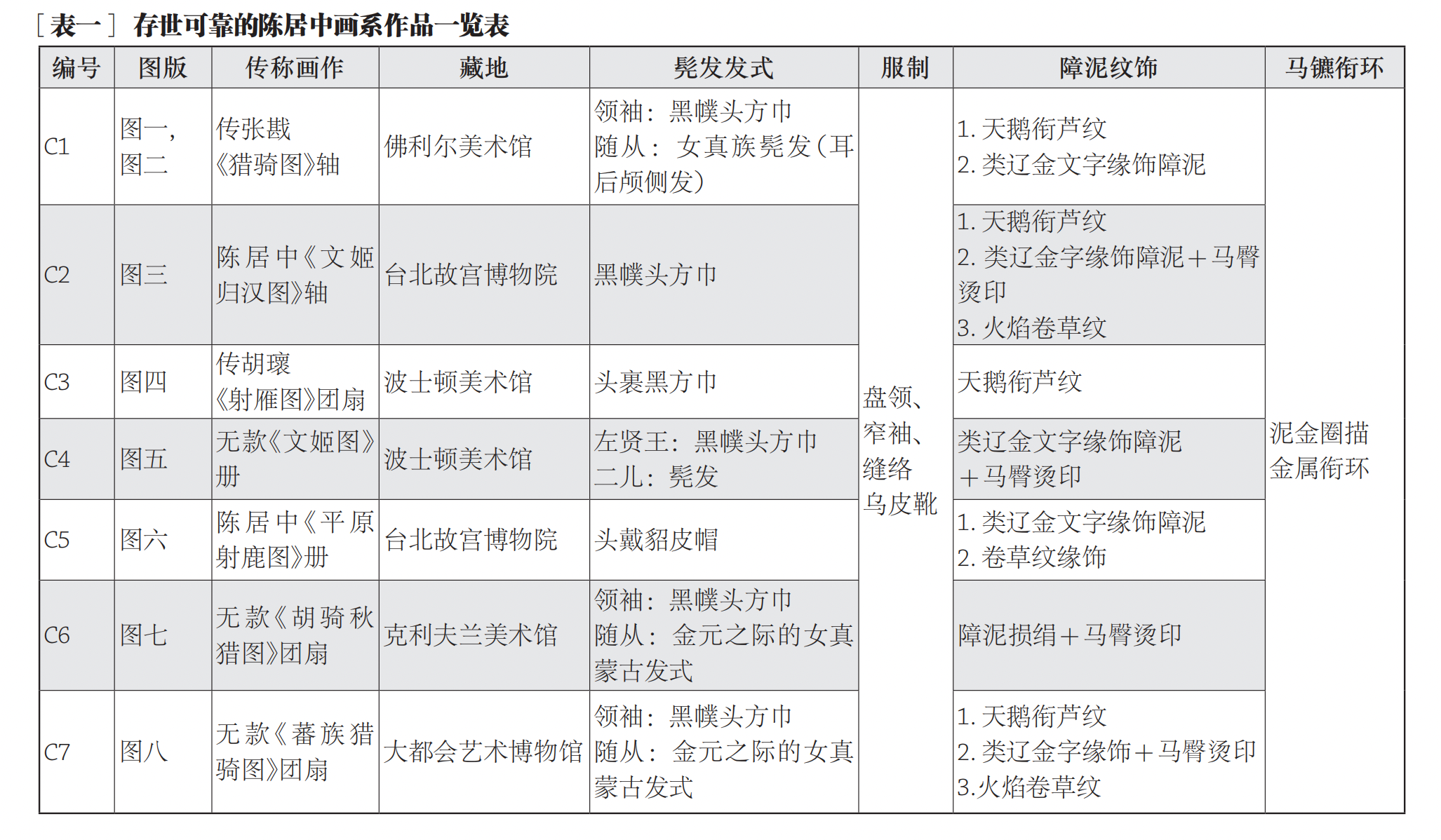
[Table I]
[Table 1] Lists seven surviving paintings for comparison. Among them, the axis of Chen Juzhong's "Wen Ji Returning to Han Tu" numbered C2, and the booklet C5 "Shooting Deer in the Plain" have long been recognized as Chen Juzhong's paintings. There is no doubt about the standard authenticity. The outline of C2 is sharp and careful, and it is meticulously carved. . C3 The figure’s hands in "Shooting Geese" in Boston, and C4 the black horse’s eyes in Boston's "Wen Ji Tu" are out of proportion because the original silk was damaged and repainted by later generations. It belongs to the painting department of Chen Juzhong. C5 Chen Juzhong's "Picture of Shooting Deer in the Plain" is the result of the painter's brushwork from fine to slightly bald, and his brushwork gradually loosened from his prime to middle age. As for C6 Cleveland's "Hu Qiqiu Hunting Picture" and C7 Metropolitan Museum of Art's "Fan Race Hunting Horse Picture", the brushwork is old and rough, with a bald short brush, easy to use, skillful and old, and it is a brushwork in old age. The lower limit of the age of Chen Juzhong's activities was later than 1232, when the Mongols sent envoys to the Song Dynasty to discuss the attack on the Jin Dynasty, and the Southern Song Dynasty sent envoys to thank them. C6 and C7 may be due to the fact that Chen Juzhong witnessed the Jurchen people at the time of the Jin and Yuan Dynasties in his later years. In addition to the high degree of consistency in the style of brush and ink in the seven paintings, Khitan and Jurchen characters are often painted on decorative rings such as horseback hot stamping, saddle mud, and robe edge decorations, which are unique symbols to identify Chen Juzhong's painting style.

〔Picture 2〕 Chuan Zhang Kan's "Picture of Hunting Riders" axis (partial) Collection of Freer Art Museum, photo by the author
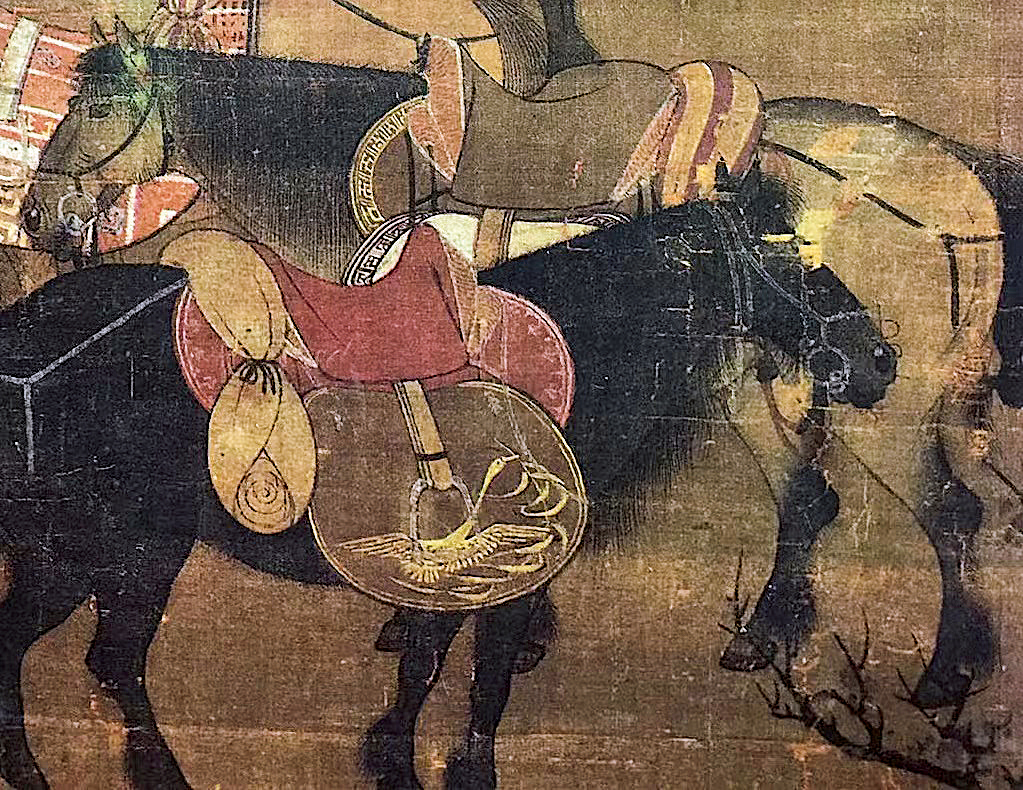
〔Picture 3〕 Chen Juzhong's "Wenji Returning to Han Dynasty" axis (partial) Collection of the National Palace Museum, Taipei
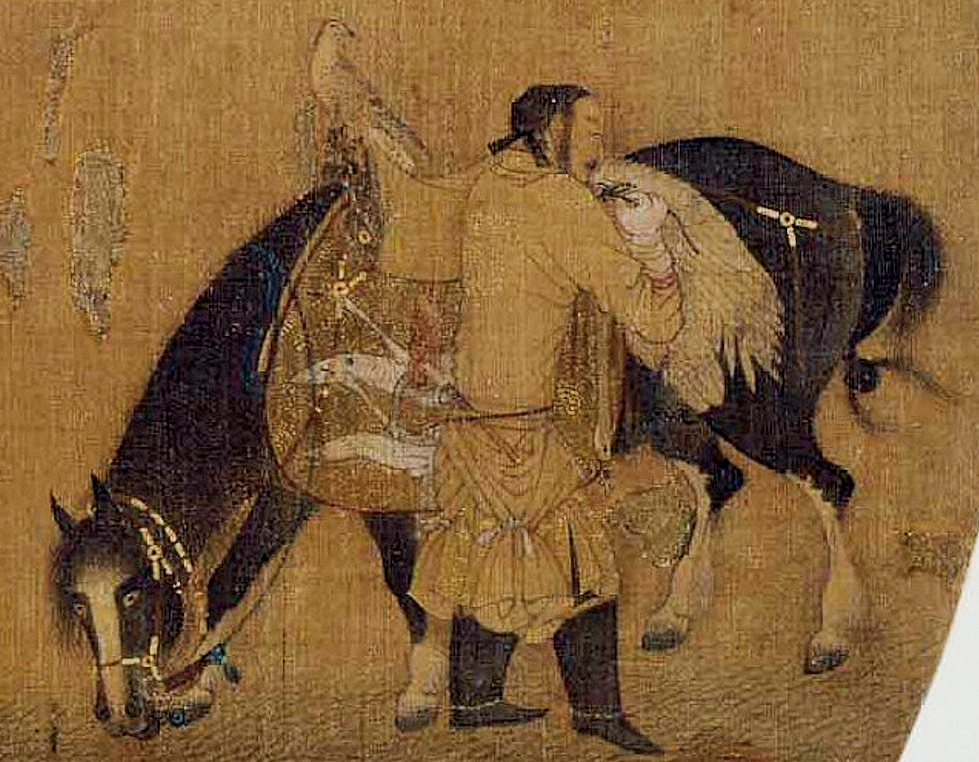
〔Figure 4〕 Chuan Hu Yu's "Shooting Goose Picture" round fan (partial) Collection of Boston Museum of Fine Arts, dagger hanging on the waist, swan holding a reed pattern painted on the barrier mud, and a large metal ring painted with lacquer gold circles on the horse

[Figure 5] Untitled "Wen Ji Tu" volume (partial) Boston Museum of Fine Arts Collection Zuo Xianwang's belt tied with a short knife, the edge of the barrier mud is decorated with "similar Liao and Jin characters" rings, and the horse is painted with a large metal circle in white powder circles, The biting part is painted with lacquered circles

〔Picture 6〕 Chen Juzhong's "Shooting Deer in the Plain" book collection of the National Palace Museum, Taipei
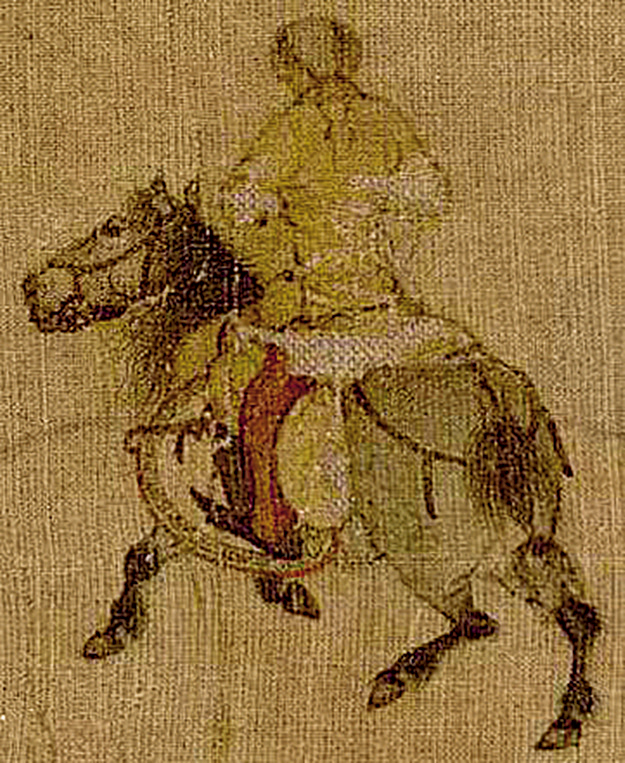
[Figure 7] Unmarked "Hu Qiqiu Hunting Picture" Tuan Fan (Part) Collection of Cleveland Museum of Art

〔Picture 8〕 Untitled Southern Song Dynasty "Fan Tribe Hunting and Cavalry Picture" Tuanfan (partial) The silk ground of the quiver part of the short knife in the Metropolitan Museum of Art is mostly damaged, and the barrier clay is painted with swans holding reeds and flames of curly grass. "Golden characters" edge decoration, hot-stamped characters painted on the horse's buttocks, and a large metal ring painted with lacquered gold circles on the horse's body
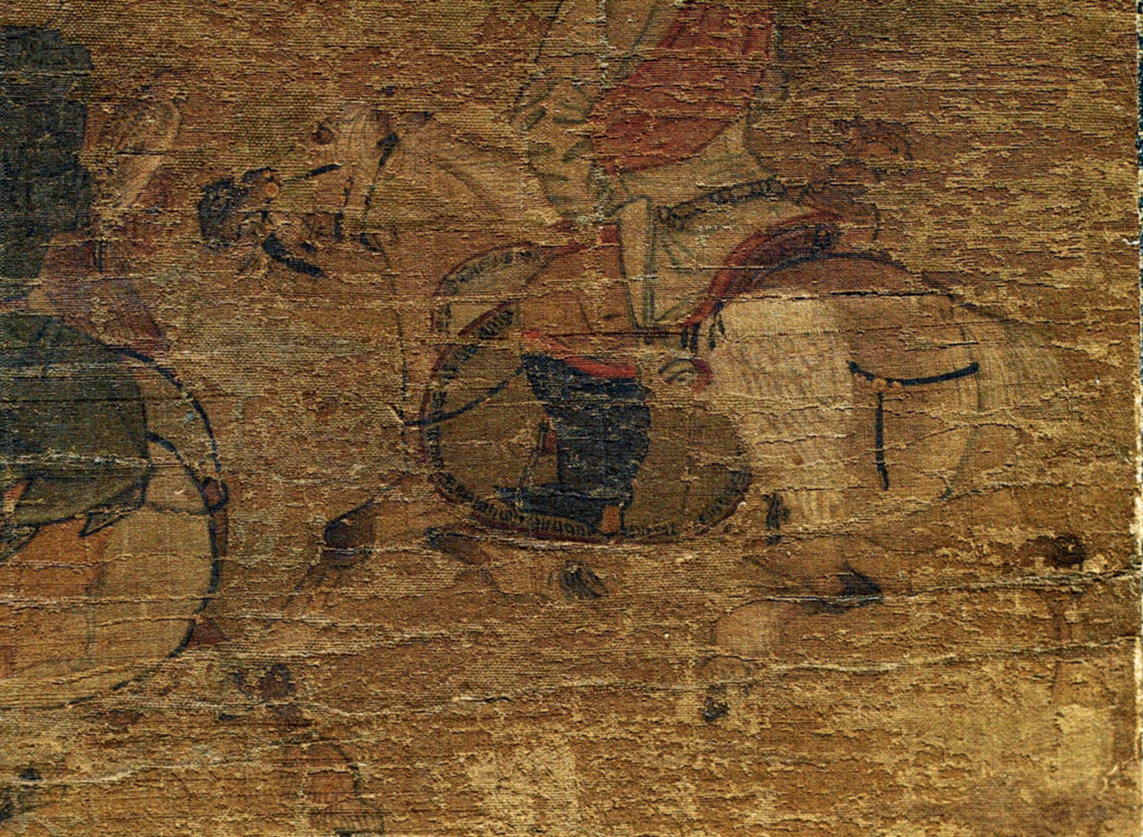
〔Figure 9〕 Biography of Zhang Kan's "Hunting Rider Picture" Shaft (partial) The edge of the mud barrier is decorated with geometric Jurchen-like characters
The original silk of "Hunting and Riding" is very dilapidated. After being mounted and repaired by later generations and unmounted and scrubbed many times, the paintings seen today mostly show signs of modification such as silk patching, brush filling, and coloring. For example, in Figure 9, it can be seen that the framer painted the narrow sleeve near the arm of the horse hunter on the right, and the turning line of the clothing pattern with leaf green, and then added a thick outline. Although the contour line of the folds of the hunter's arm has been thickened by the writer and lost its original appearance, the high degree of realism of the original work can still be seen on the untouched part of the original silk (Fig. 10). Excluding mounting factors such as supplementary strokes and color enhancement, "Hunting Riding Picture" has exquisite short brush strokes and high brush control ability, which are exactly the same as the standard Chen Juzhong's paintings numbered C 2 to C 7 (Figure 11).
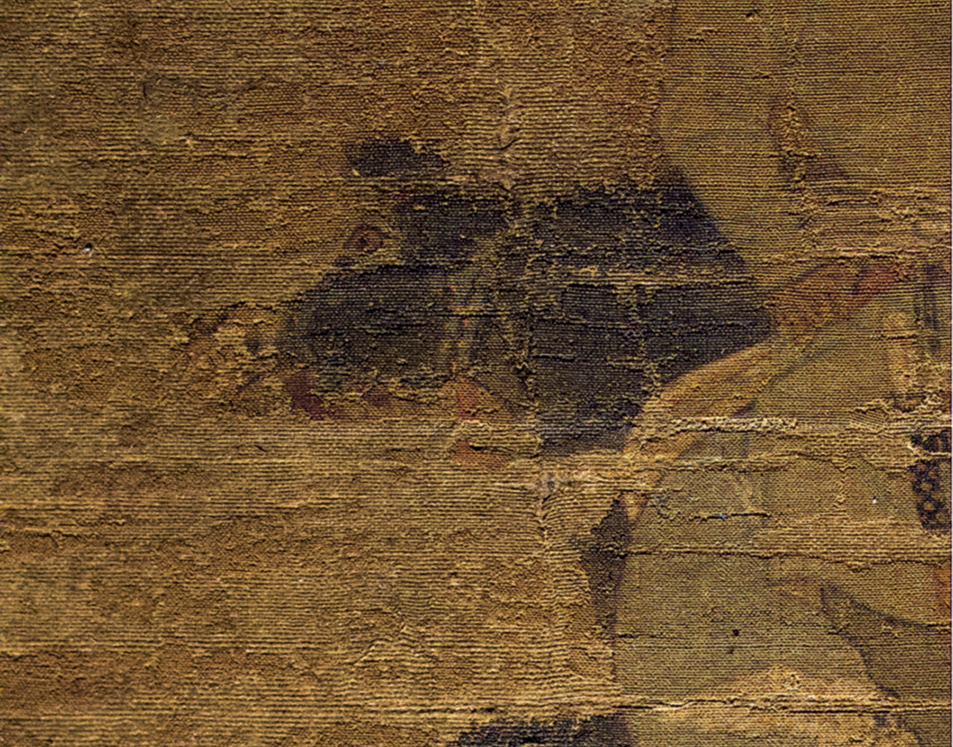
〔Picture 10〕 Chuan Zhang Kan's "Hunting Rider Picture" Shaft (partial) Where the original silk has not been filled with pen, a short knife at the waist
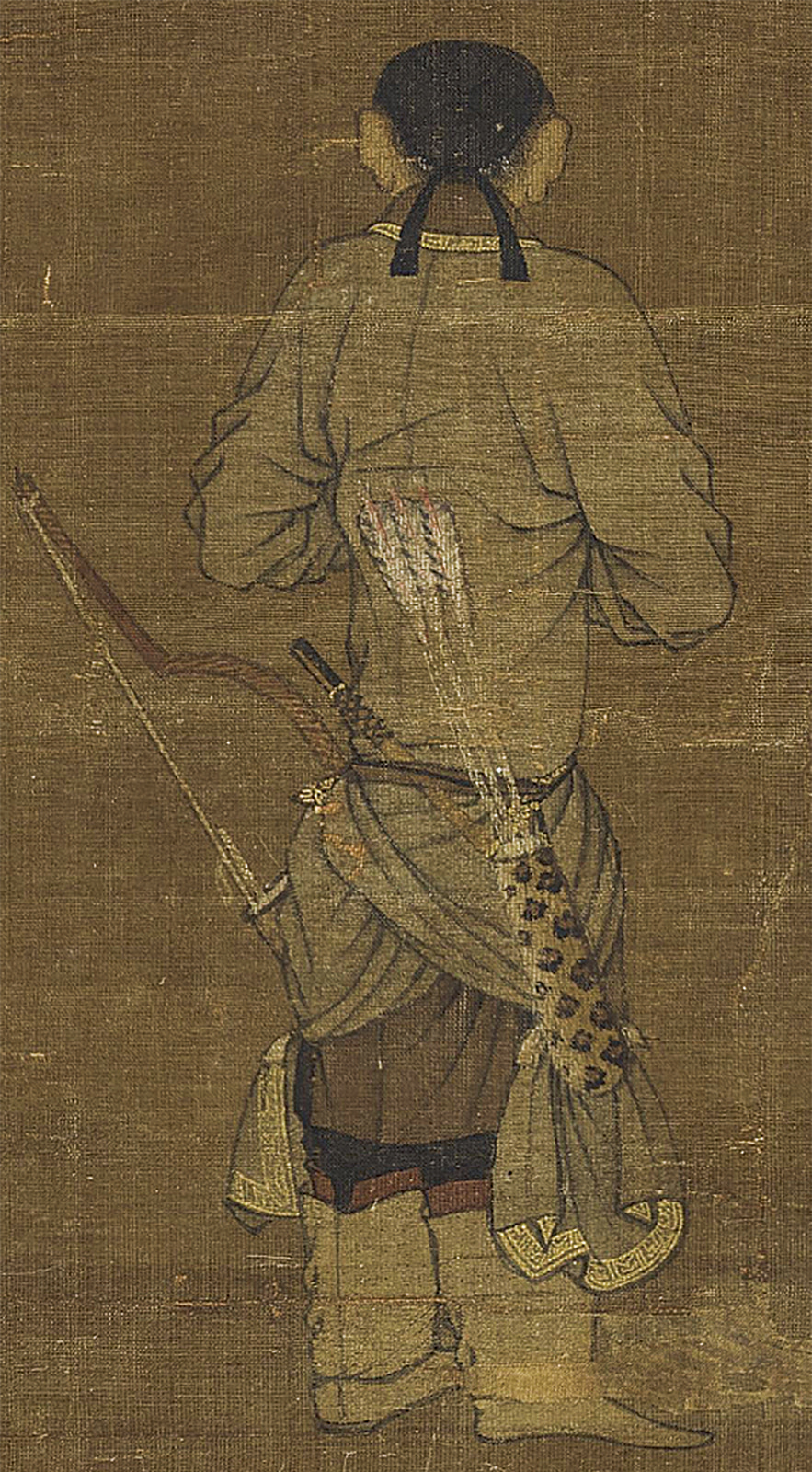
〔Picture 11〕 Chen Juzhong's "Wen Ji Returning to Han" axis (partial) Collection of the National Palace Museum, Taipei
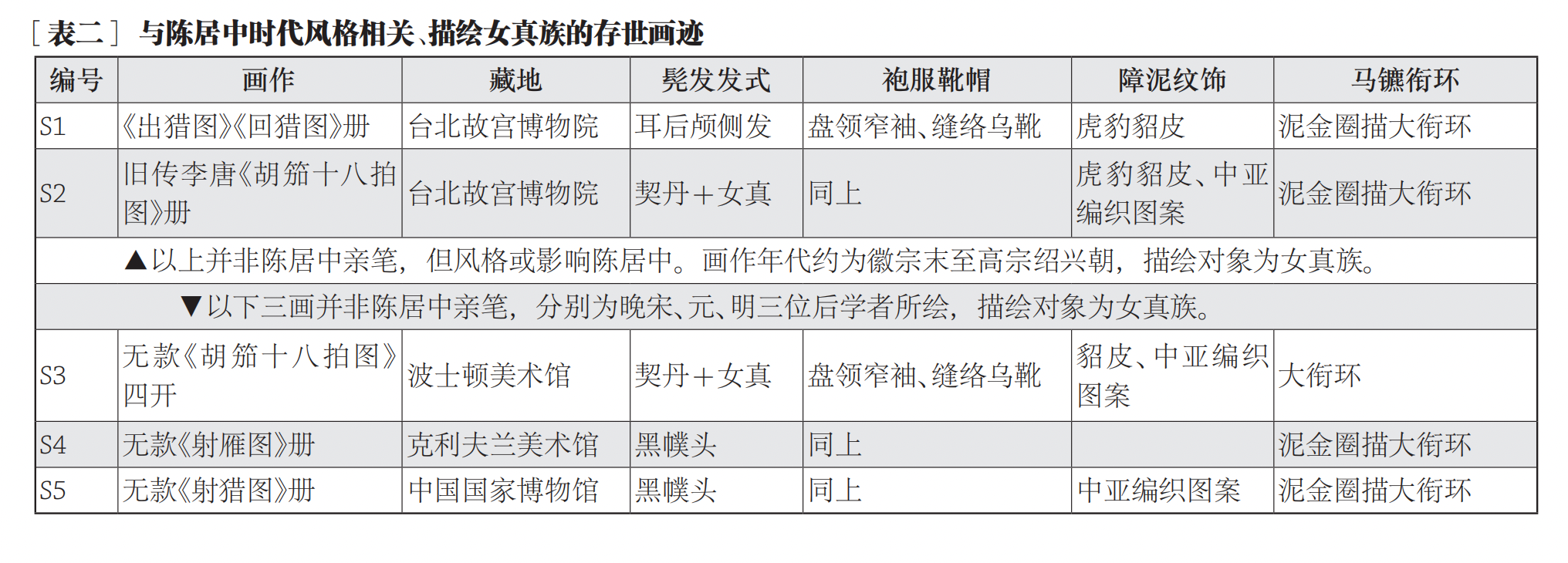
[Table II]
Compared with the first-class authentic works by Chen Juzhong, the six paintings listed in [Table 2] also depict the Jurchen tribe, and the style has been inherited from generation to generation, but they were not written by Chen Juzhong. Among the six paintings, the book "Out of Hunting" and "Returning to Hunting" in the National Palace Museum in Taipei (No. S1, Figure 12) depicts the hot stamping of the word "Su" (Sushen means Jurchen) and the hot stamping of Jurchen characters on the horse's buttocks. In the Huizong Dynasty (1110-1125) of the Northern Song Dynasty (1110-1125), the newly rising Sushen-Jurchen image was drawn by Fanma painters, and the style influenced Chen Juzhong later. The National Palace Museum in Taipei's "Eighteen Photographs of Hu Jia" (No. S 2, Figure 13) was made by a painter during the Shaoxing period of Emperor Gaozong of the Southern Song Dynasty (1131-1162), and three ethnic languages of Khitan, Jurchen, and Turkic are seen on the horse's buttocks Hot stamping ‹1›. The two paintings S1 and S2 can be regarded as the forerunner of Chen Juzhong's previous style.
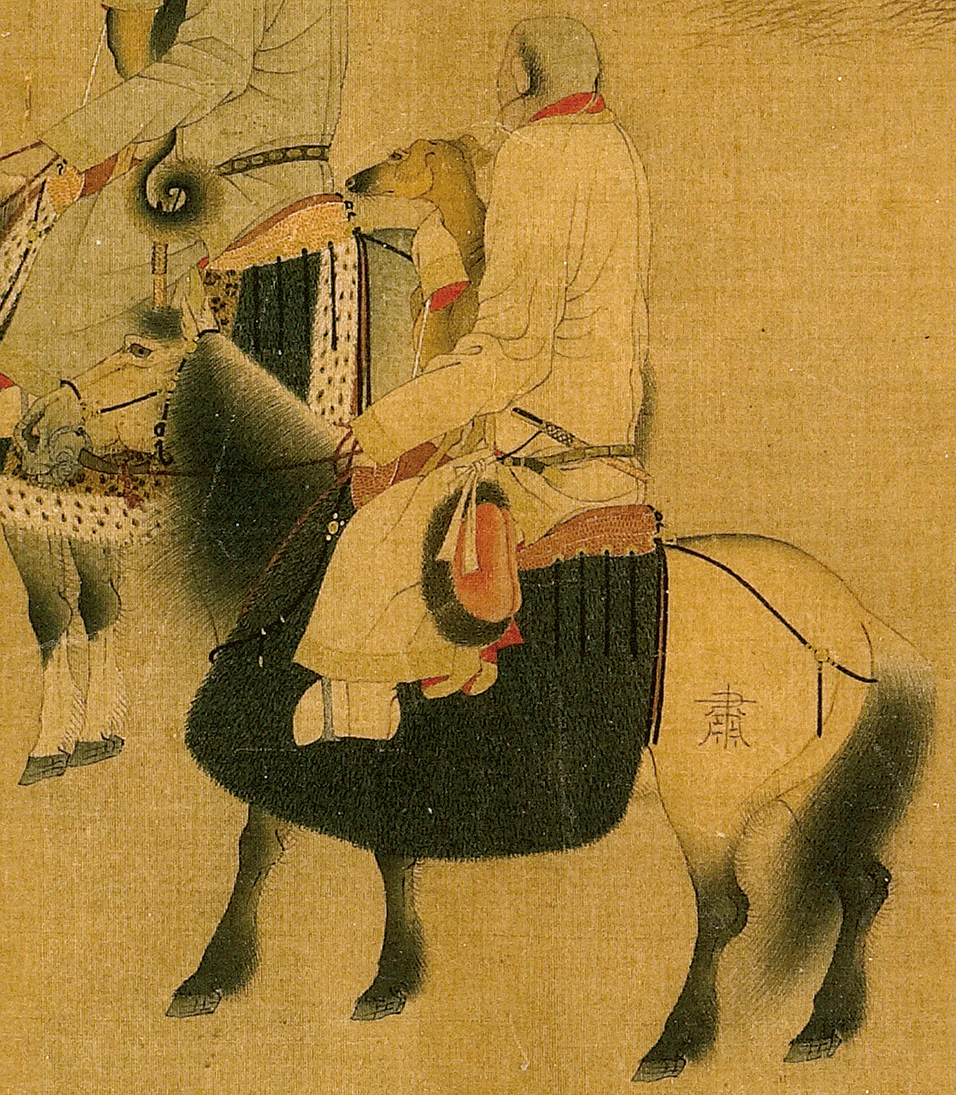
〔Picture 12〕 "Returning Hunting Picture" Book Collection of the National Palace Museum, Taipei
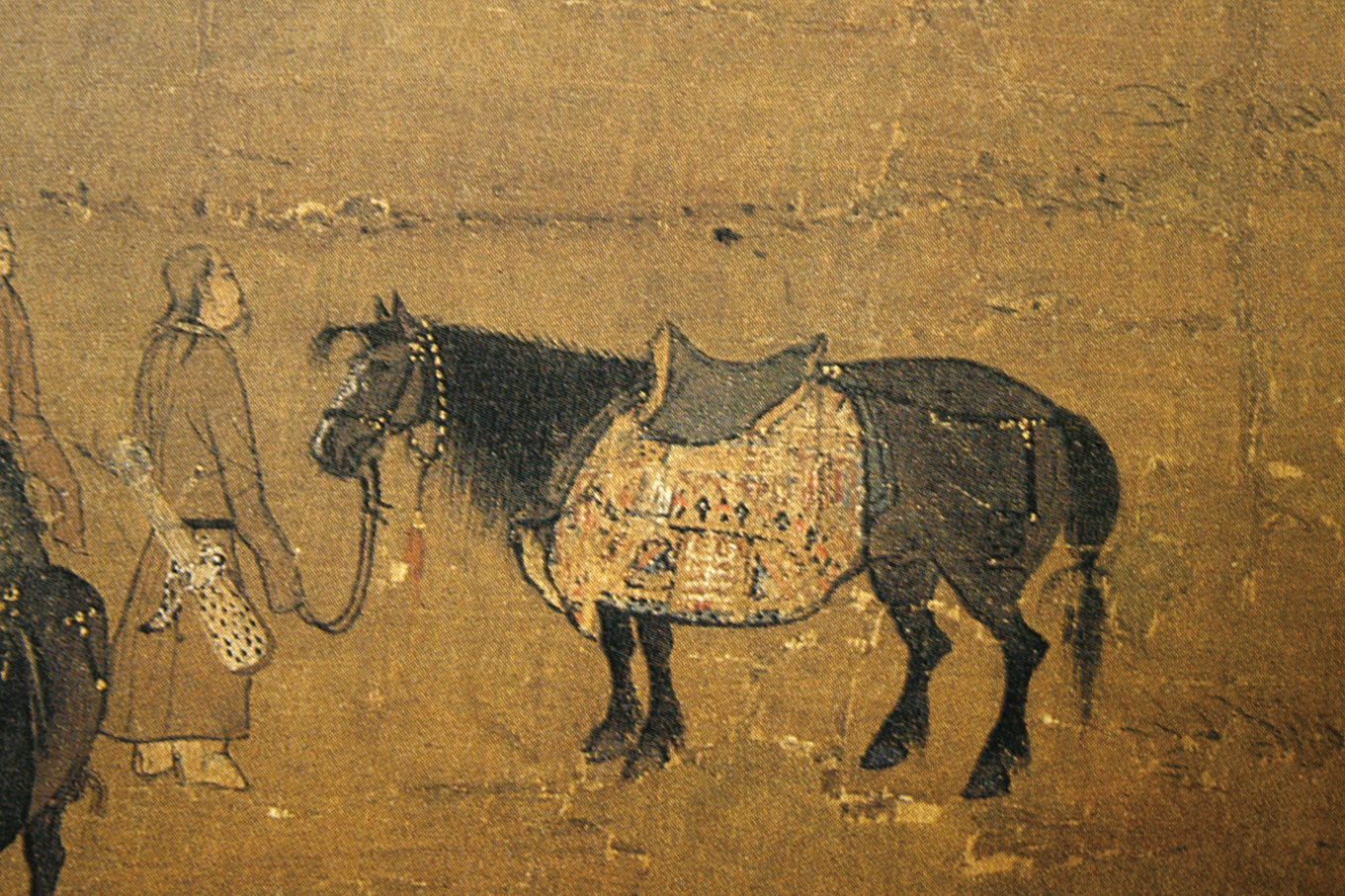
〔Picture 13〕The old biography of Li Tang's "Eighteen Photographs of Hu Jia" volume (partial), about 1160s, in the collection of the National Palace Museum, Taipei. The brushwork is slightly sloppy compared to the standard Chen Juzhong paintings, and can be regarded as the forerunner of Chen Juzhong's style. The painter is familiar with the Jurchen robes, saddles and national characters
After Chen Juzhong, there are three other postgraduate works from the end of the Southern Song Dynasty to the Yuan and Ming Dynasties: Boston Museum of Fine Arts' unsigned "Hu Jia Eighteen Photographs" square book (No. S3), Cleveland Museum of Art's unspecified "Shooting Geese" The volume (Three Horsemen Hunting Wild Geese, No. S4) was written by two other post-scholars in the late Southern Song Dynasty. Although the unmarked "Shooting Picture" in the National Museum of China (No. S5) tries to imitate Chen Juzhong's style, but the brush and ink are slightly inferior, the colors are stiff, and the style of the era has entered the Yuan and Ming Dynasties.
2. Ethnological indicators for judging that Zhang Kan's "Hunting Tu" depicts the Jurchen people
(1) Hair style of "hair on the side of the skull behind the ear"
It is said that the hairstyles of the three hunters in Zhang Kan's "Hunting Horses" have distinct characteristics of the times. The head of the leader at the top is wrapped with a black headband, and the square scarf is tied with a knot and then hangs down with a short belt. This style is also found in Chen Juzhong's "Wen Ji Returning to Han Picture" axis, "Shooting Wild Goose Picture" round fan, "Wen Ji Picture" booklet, "Hu Qiqiu Hunting Picture" round fan, "Fan Tribe Hunting Horse Picture" round fan and other standards Chen Juzhong's painting (Fig. 14).
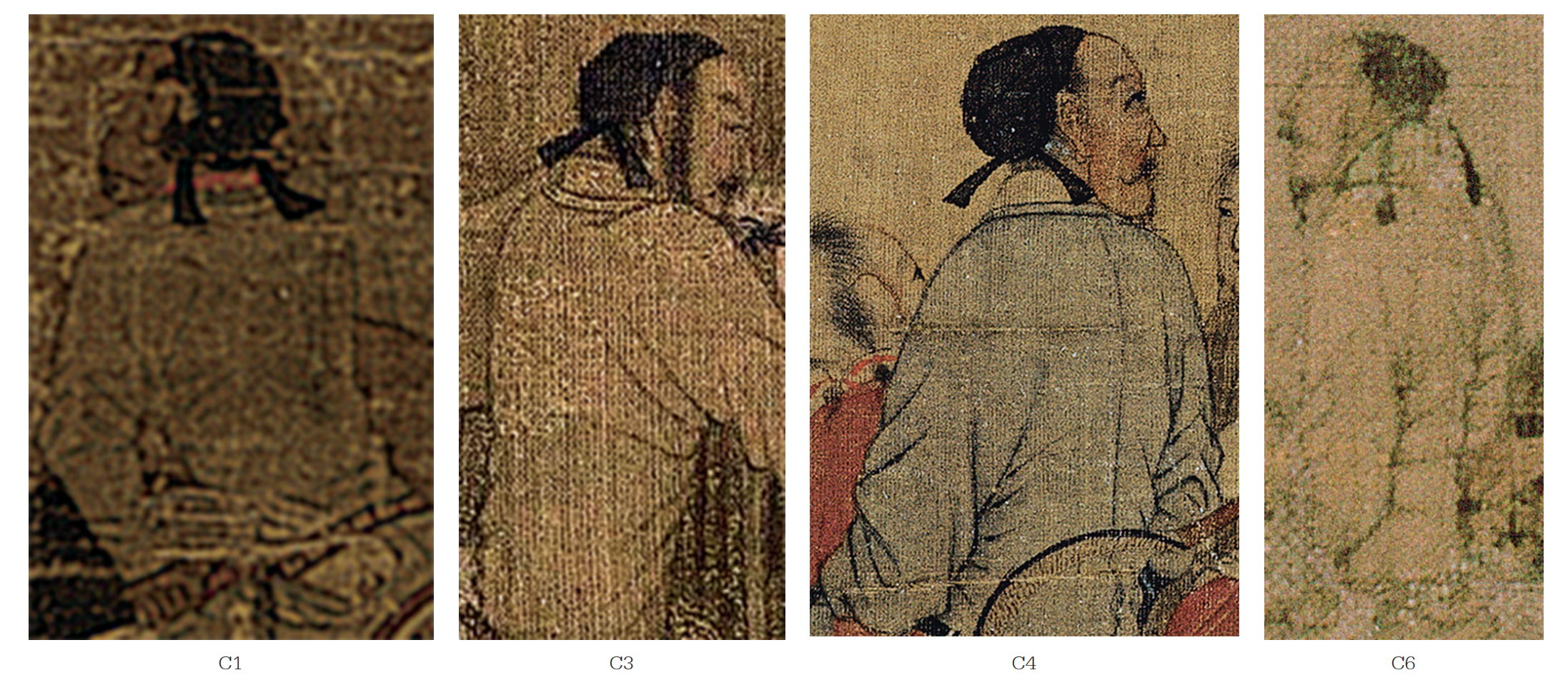
[Figure 14] Biography of Zhang Kan's "Hunting Rider Picture" axis and Chen Juzhong's black head scarf

[Figure 15] According to Zhang Kan's "Hunting Rider Picture", the shaft (partial) Kun has "behind the ear and lateral cranial hair"
It is said that the two attendants at the bottom of Zhang Kan's "Hunting Horse Picture" have "hair on the side of the head behind the ears" (Fig. 15), the top hair is shaved off, leaving only sparse side hair on the side of the head, the hairline is behind the ears, and the short hair is braided , hanging from behind the ear. According to "Dajin Guozhi", "Dajin Hanging Records", "Song Huiyao Compiled Drafts", "Song Shaobaoyue King Xingshi Chronicle", before the middle Jin period, the Jurchen's hair "cut the hair upside down", "weave the hair and expose the top", "cut the hair" Bald and drooping hair" and "shaved and braided hair" are the same as Zhang Kan's "Hunting and Riding Picture". This style of cutting the top hair upwards and leaving only the hair behind the ears and the side of the skull is also recorded in the imperial edict issued by Emperor Taizong of Jin in 1126: "It is appropriate to return to the dynasty, and it is appropriate to follow the customs. It is also necessary to cut the hair upwards and wear a short scarf on the left lapel. Anyone who dares to violate the law will be nostalgic for the old country, and should not miss it as a punishment." This edict revealed the official ideology of the Kingdom of Jin. For the Jin people, whether the hair on the back of the head is behind the ears or not is a national symbol for distinguishing Jurchen and non-Jurchen. It can be seen from [Table 3] that all the tomb murals depicting "hair on the side of the skull behind the ear" belong to the golden tomb. Such as Jinan Shangfu No. 1 Golden Tomb mural "Portrait of a Man", Shanxi Pingding Xiguan Village Golden Tomb mural "Camel Transport Picture" and "Inner House Picture", and Aohan Banner Yingfenggou Jinchu Sarcophagus painting "Male Attendant". Except for numbers C2, C3, C4, C5, S4, and S5, which are not covered with shaved hair due to the head covering of the surviving Song and Jin Dynasties, the remaining paintings related to Chen Juzhong’s painting series [Table 1, Table 2] and the Palace Museum Collection The hairstyles of Jurchen haircuts in "Zhuoxie Picture" volume (Figure 16) and the round fan in "Liutang Herding Horse Picture" are all the same as those in Zhang Kan's "Hunting Horse Picture". Hairstyle for Jurchen.

[Table 3]

[Figure 16] Jin Dynasty "Zhuo Xie Tu" Volume Collection of the Palace Museum
(2) Clothes, boots and hats such as "coiled collar and narrow sleeves" and "sewn black boots"
It is said that the three hunters in Zhang Kan's "Hunting Horses" all wear white and green robes, with round collars and narrow sleeves, and the red shirts are exposed inside the robes. The belts are the leather belts commonly used in the Song and Jin Dynasties, not the seven belts of the Khitan, Dangxiang and other clans recorded in "Liao History" and "Khitan Guozhi". Among the three riders, a straight-handled iron knife hangs from the waist of the leader. The scabbard is made of leather, yellow and black, and the surface is decorated with black diagonal grids. The regulation of this iron knife is in line with the Jurchen tribe's "right-fitting knife, the knife is expensive with a handle, and it is a rooster and snake wood, half yellow and black, and the one with black double distance is the best" recorded in "Jin Shi·Yu Fu Zhi". Similar to the half-yellow and black knife handle with black double spacing, it can also be seen in Chen Juzhong's painting series, such as the axis of Chen Juzhong's "Wen Ji Returning to Han" (see Figure 11), the round fan of "Shooting Wild Goose", and the Boston Museum of Fine Arts. Wen Ji Tu" and Chen Juzhong's "Plain Shooting and Hunting Pictures" (Figure 17), as well as Chen Juzhong's "Hunting Picture" and "Returning Hunting Picture" volumes (see Figure 12), "Hujia Eighteen" related to the style of the era before and after Chen Juzhong Pai Tu" volume [see Figure 13], "Zhuo Xie Tu" volume [see Figure 16] and other Fanma paintings depicting the Jurchen tribe.

[Figure 17] Biography of Zhang Kan's "Hunting Rider Picture" scroll and Chen Juzhong's black and yellow iron knife, double leather saddle pad
It is said that the style of leather boots in Zhang Kan's "Hunting Horses" is "sewn black leather boots". It is made by stitching the boots, boots, and soles. The toe of the boot is sharp, the sole is long, the heel is reinforced with a layer to protect the ankle, and the upper part of the foot is bound by a thin thread. Among the paintings handed down from generation to generation, the seamed black boots of the same style as this painting include standard Chen Juzhong paintings numbered C2 to C7, numbers S1 to S6, and the group fan "Liutang Herding Horses" depicting the Jurchen tribe.
(3) "Swan holding reed" and "Jurchen-like decorative belt" depicted in saddle mud

〔Picture 18〕 Biography of Zhang Kan's "Hunting Horses" and Chen Juzhong's painting of a swan holding a reed made of mud
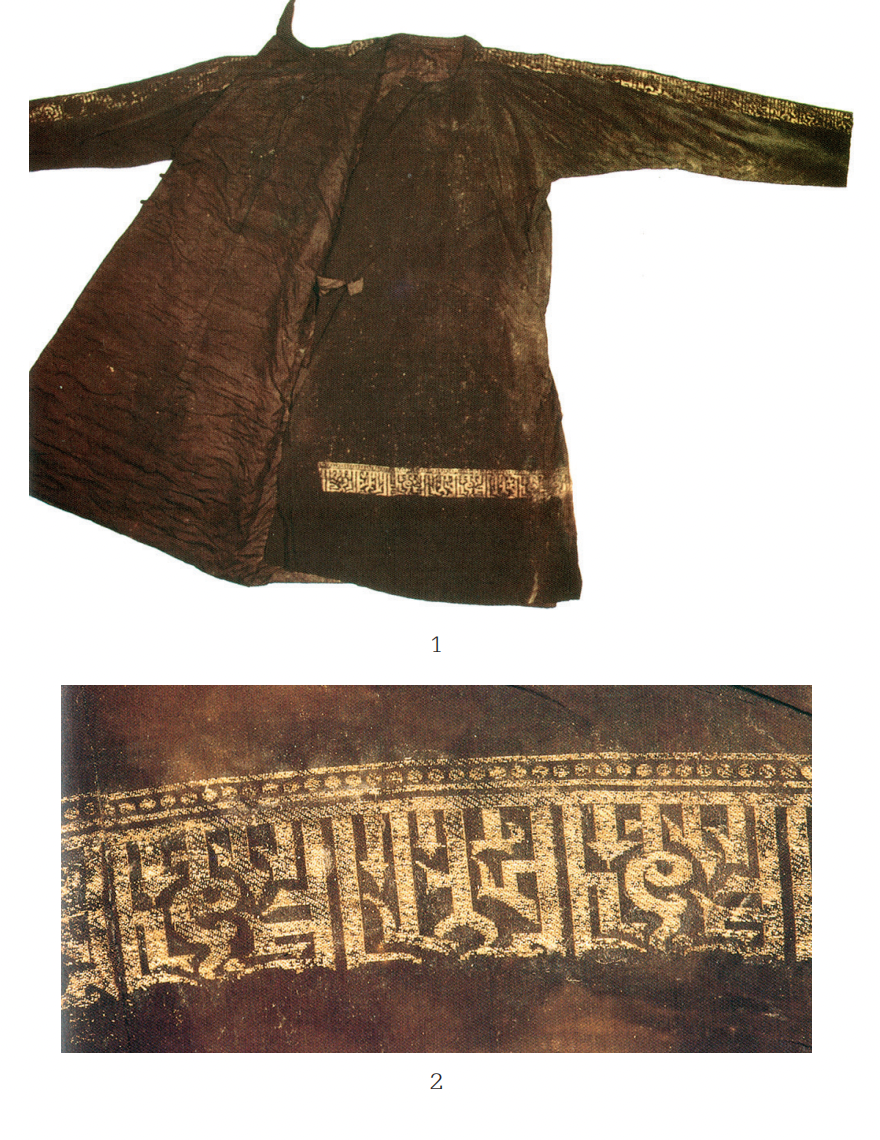
〔Figure 19: 1, 2〕 Jurchen aristocratic costumes, unearthed from the tomb of King Qi in the Jin Dynasty in 1162, collected by the Heilongjiang Provincial Museum
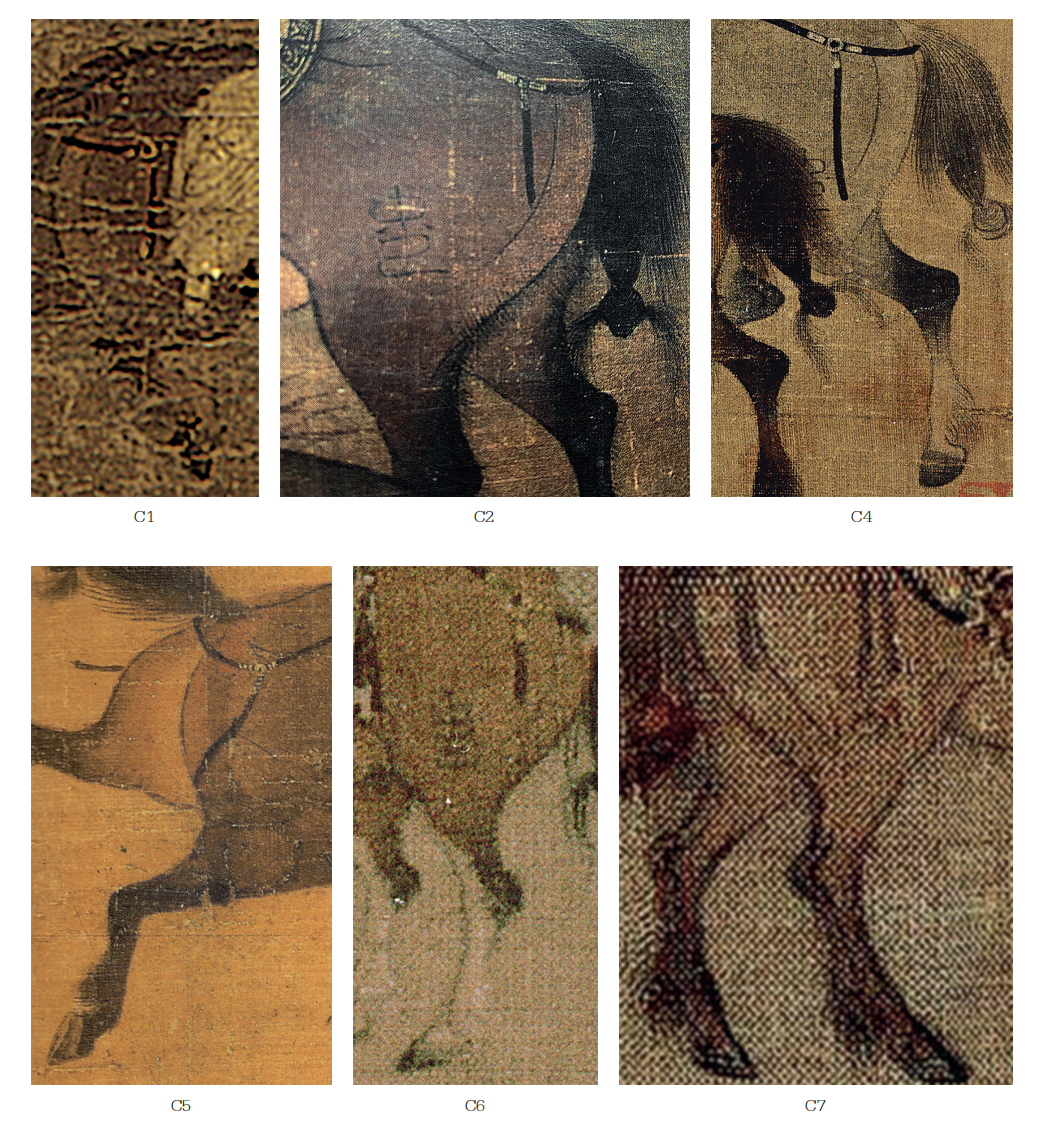
〔Picture 20〕 Chuan Zhang Kan's "Hunting Riding Picture" axis and Chen Juzhong's horse buttocks, horse legs, black reins, and small metal rings drawn in lacquered gold circles. Among them, C2, C4, C6, and C7 have Jurchen painted on the horse's buttocks Small print hot stamping

〔Picture 21〕 "Dajin Deshengtuo Stele" (1185) Jurchen small characters seen on the underside of the stele Unearthed in Jilin Province Jin Xizong issued an edict in 1138 and Jurchen small characters became popular in 1145
It is said that Zhang Kan's "Hunting Horses" does not use saddle bridges. The saddle is double-layered, with leather leather pads, and each layer carefully depicts the leather texture. The barrier mud has a large oval shape. The bottom of the barrier mud is lower than the horse's belly, the front end covers the horse's chest, and the rear end covers the horse's buttocks (see Figure 9). Standard Chen Juzhong styles numbered C2 to C6, such as the axis of "Wen Ji Returning to Han Tu" (see Figure 3), and the volume of "Shooting Deer in the Plain" (see Figure 6). This feature can be seen in the numbered S series, such as the copy of Chen Juzhong's "Shooting on Horses" in the Yuan and Ming Dynasties. It is said that Zhang Kan's "Hunting and Riding Picture" has a swan holding a reed pattern painted on the barrier mud of the forerunner. The barrier mud is made of stone green as the base, and the swans are dyed with hufen and ochre. Using stone-based pigments to depict rich and elegant spring water patterns with warm colors as the overall tone. This pattern of a swan holding a reed is in line with Chen Juzhong's painting style, such as the axis of Chen Juzhong's "Wen Ji Returning to Han", the round fan in "Shooting Wild Goose" (Figure 18), and the "Spring Nap" recorded in "Jin Shi·Yu Fu Zhi" Goose Hunting Customs: "The common clothes of the Jin people include four-band scarves, collared clothes, and black leather boots...the chest and shoulder sleeves may be decorated with gold embroidery. The clothes from the spring water are mostly falcons catching geese and miscellaneous flowers. Decoration." The geometric "Jurchen-like characters" are included in the painting, depicting the decorative belt on the edge of the barrier mud, which is a unique motif in Chen Juzhong's painting department. Chen Juzhong was on a voyage to the Kingdom of Jin in 1207, and he had heard a little about Jurchen characters. He could see similar [Figure 19, the object unearthed from the tomb of King Jin Qi in 1162, collected by the Heilongjiang Museum] with geometric decorations on the edges of the Jurchen aristocratic costumes. Although Chen is not a Jurchen, he is not fully familiar with the Jurchen characters, and can only describe them vaguely, but these experiences in the north make him more accustomed to using geometric and "Jurchen-like characters" symbols to describe horses than other Fanma painters. Hot stamping on the buttocks, the yoke decoration on the edge of the robe, and the decorative belt of mud mud. Chen Juzhong’s paintings depicting hot stamping of horse’s buttocks, such as the axis of “Wen Ji Returning to Han”, the round fan of “Hu Qiqiu Hunting”, the volume of “Wen Ji Tu”, and the round fan of “Fan Tribe Hunting Horses” (Fig. 20, Fig. 2) eleven〕. The geometric pattern similar to Jurchen characters is used as the decorative belt of the robe, including the scroll of "Wen Ji Returning to Han" and "Wen Ji Tu" volume. The "Picture of Shooting Deer in the Plain", the round fan of "The Picture of Fan Tribe Hunting Riders", and the outer edge of the round fan of "Hu Qiqiu Hunting Picture" also have geometric patterns similar to Jurchen characters (Fig. 22). Those who are not from the Chen Juzhong painting department do not have this habit. It is said that the geometric Jurchen-like characters on the edge of the barrier mud in Zhang Kan's "Hunting Horses" are in line with Chen Juzhong's usual motif.
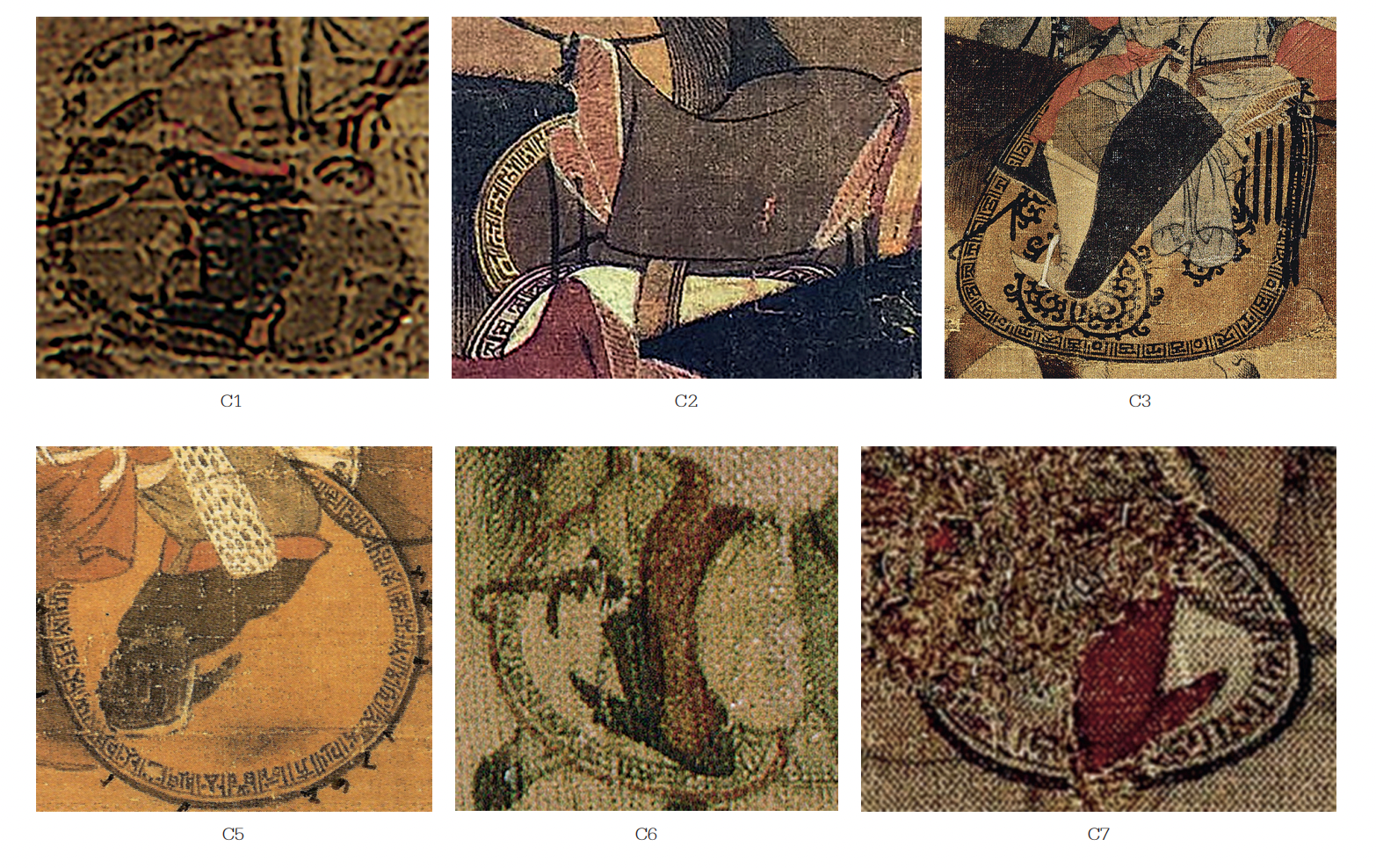
(Figure 22) Biography of Zhang Kan's "Hunting Riding Picture" The axis and Chen Juzhong's paintings are usually decorated with "like Jurchen characters" or geometric characters, of which only a few patterns are decipherable Jurchen characters, most of which are fabricated
(4) Horse guard without hook
According to Zhang Kan's "Hunting and Cavalry Picture", the horse's bicep near the horse's teeth is painted with a large bit ring with lacquered gold circles, and the horse bit is connected by 2-3 small gold rings, and the two ends are inlaid with larger bit rings. Under the large bit ring is a wide leather belt, the leather belt is thick and thin, and the end is tied with a thin rein. This "ring-shaped" horse is more convenient than the Liao Dynasty horse in terms of traction, control and feeding. Most of the murals in Liao tombs and the unearthed horses are horn-shaped or hook-shaped. Compared with the hook-shaped horses of the Liao Dynasty, the ring-shaped horses appeared later, and were common in paintings of horses and horses in the Jin Dynasty and the Southern Song Dynasty in the 12th and 13th centuries. Among the paintings handed down from generation to generation, as many as 21 paintings by the court painters of the Jin Dynasty and the Southern Song Dynasty have this style. For example, the fanma painting (Fig. 23) related to Chen Juzhong’s style, as well as the album of "Spring Outing Evening Return" in the Southern Song Dynasty, the round fan of the "Han Gongtu" in the Southern Song Dynasty, and the "Snow Landscape Landscape" album of Biography Liang Kai, Taipei. The Palace Museum's "Hu Jia Eighteen Photographs", Jin Yangwei's "Two Horses" volume, and Jin Zhangyu's "Wen Ji Returning to Han Picture" volume, all of the horses are ring-shaped. Iron-cast rings can be found in the horse bibs unearthed from golden tombs, such as the Jinchu tomb in Jiuzhan, Yongji County, Jilin Province, the golden tomb in Shuangcheng Village, Acheng City, Heilongjiang Province, and the Qianpawnshop in Xinmin County, Liaoning Province. It can be confirmed that Zhang Kan's "Hunting Riding Picture" is dated to the Jurchen style in the 12th and 13th centuries, and the contours drawn with lacquer gold circles are also a common feature of Chen Juzhong's painting style.
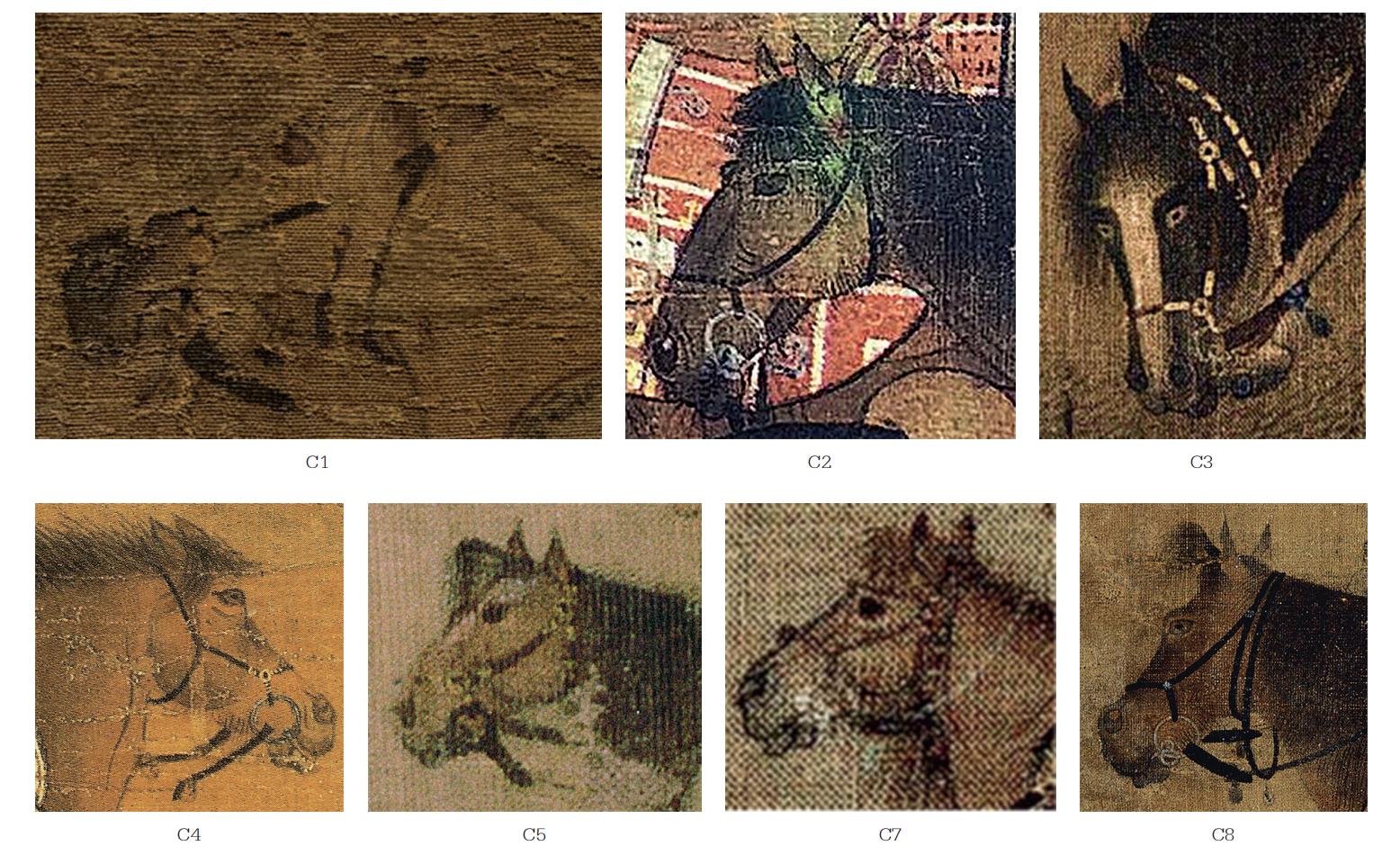
(Figure 23) Biography of Zhang Kan's "Hunting Rider Picture" axis and Chen Juzhong's painting style of horse head shape, pear nose painting method, large metal rings on both sides of the horse bit, and small lacquered rings on the top
3. Summary
Zhang Kan, a Waqiao painter in the Northern Song Dynasty who lived in Liao in the 10th century, has no authentic works in existence. Both Zhang Kan's "Unpacking the Saddle and Adjusting the Arrow" and "Hunting the Horse" in the Freer Museum of Art have nothing to do with it. "Hunting Horses" was painted by Chen Juzhong, a court painter in the Southern Song Dynasty, and the object of the depiction is not the Khitan, but the Jurchen. The pen and ink line drawing in the painting, the Mongolian pony, the side hair behind the ears, the narrow collared sleeves, the sewn black boots, the half-yellow and black short knife, the ring-shaped horse guard painted in lacquer gold circles, and the "Khitan-like Jurchen characters" "The outer edges of the decorative barrier mud are all characteristics of Chen Juzhong's paintings, and are similar to the axis of Chen Juzhong's "Wen Ji Returning to Han", the round fan of "Shooting Wild Goose", the volume of "Wen Ji Tu", "Plain Shooting Deer" volume, "Hu The Tuan Fan and the Tuan Fan of Riding in Autumn Hunting Picture and the Tuan Fan of Fan Tribe Hunting Horses were written by the same person.
Looking back before the 1990s, the art historians had stereotyped the Khitan and Jurchen ethnic groups, and used to interpret the ethnic minorities with craniofacial hair seen in the handed down Liao and Jin paintings as the Khitan. For example, Tomita Kojiro (1928), Ryuzo Torii, Shen Congwen (1959), Shimada Shūjirō (1962), John Haskins (1963), and Robert Rorex (1974; 1983) believed that several surviving copies of "Wen Ji Gui Han Tu" and the National Palace Museum in Taipei In the Tibetan Hu Gu’s "Hunting Picture" and "Hunting Picture", the Hu people with hair on the side of their skulls are all Khitan. Those with side hair. Scholars of this generation have never paid attention to the differences in details between the Jurchen hairdressing system and the Khitan. They only emphasized how the Jurchen was Sinicized, and how the Jin Dynasty literati Wang Tingyun (1151-1202) and Zhao Bingwen (1159-1232) etc. The above is the inheritance of the literati tradition of the Northern Song Dynasty, and how Jin Zhangzong (1168-1189) imitated the calligraphy and painting collection system of Huizong of the Northern Song Dynasty.
Now, through the study of Zhang Kan's "Hunting Horse Picture", it not only breaks the old academic theory that the person with cranial hair is the Khitan nationality, but also adds a newly discovered painting by Chen Juzhong. Chen Juzhong, who was envoy to the Kingdom of Jin in the north of Shanxi Province in 1207, is a key figure in the study of the image of the Jurchens. The Jurchen hunters galloping across Shuomo in his works proves that, except for several key cities with deep Sinicization (such as Shangjing and other political capitals, Shanxi Pingyang and other print printing centers), in the Jin Dynasty, a considerable proportion of The Jurchens still maintain the inherent custom of spring mountains and autumn waters. This group of Jurchens, with long hair and narrow sleeves, occupying the territory of the Central Plains, inherited Khitan at the top and enlightened the Mongols at the bottom, so that the nomadic peoples of the Liao, Jin, Yuan and other three dynasties in northern Serbia occupied an important place on the geopolitical stage of East Asia. It can even be further determined that there are more surviving scroll paintings depicting the Jurchen tribe than those depicting the Khitan tribe. For example, the paintings of Huang Zongdao (1120s) in the Northern Song Dynasty, Chen Juzhong in the Southern Song Dynasty, Zhao Lin (active in 1161-1189) of the Jin Dynasty "Six Horses in Zhaoling" volume, Yang Wei's "Two Horses" volume (made in 1184) , Zhang Yu (1200s) "Wen Ji Returning to Han Tu" volume, Taipei Palace Museum version "Wen Ji Returning to Han Tu", Boston version "Wen Ji Returning to Han Tu", volume "Zhuo Xie Tu" collected by the Palace Museum, Taipei National Palace Museum The "Hunting Picture", "Returning Hunting Picture" and so on collected by the museum all depict Jurchen.
(The author of this article is the History Department of Hangzhou Normal University. The original title is "Khitan or Jurchen? Zhang Kan's "Hunting and Riding Picture" in the Freer Art Museum." The full text was originally published in the "Palace Museum Journal" July 2023 Issue. The notes were not included when The Paper reposted.)
